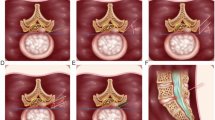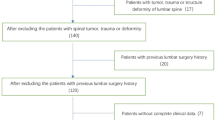Abstract
Background
Compared with lower lumbar disc herniations, upper lumbar disc herniations at L1–L2 and L2–L3 have specific characteristics that result in different surgical outcomes after conventional open discectomy. There are no published studies on the feasibility of percutaneous endoscopic lumbar discectomy for upper lumbar disc herniation. The purpose of this study was to assess the clinical outcome, prognostic factors and the technical pitfalls of PELD for upper lumbar disc herniation.
Method
Forty-five patients with a soft disc herniation at L1–L2 or L2–L3 underwent percutaneous endoscopic discectomy. Posterolateral transforaminal endoscopic laser-assisted disc removal was performed under local anesthesia. Clinical outcomes was assessed using the Prolo scale. The prognostic factors associated with outcome were then analyzed.
Findings
The mean follow-up was 38.8 months (range, 25–52 months). The outcome of the 45 patients was excellent in 21 (46.7%), good in 14 patients (31.1%), fair in six patients (13.3%), and poor in four patients (8.9%). Four patients with a poor outcome underwent further open surgery. Mean scores on a visual analog scale decreased from 8.38 to 2.36 (P < 0.0001). Age less than 45 years and a lateral disc herniation were independently associated with an excellent outcome (P < 0.05).
Conclusions
Patient selection and an anatomically modified surgical technique promote a more successful outcome after percutaneous endoscopic discectomy for upper lumbar disc herniation.




Similar content being viewed by others
References
Ahn Y, Lee SH, Park WM, Lee HY (2003) Posterolateral percutaneous endoscopic lumbar foraminotomy for L5-S1 foraminal or lateral exit zone stenosis. Technical note. J Neurosurg 99(3 Suppl):320–323
Ahn Y, Lee SH, Park WM, Lee HY, Shin SW, Kang HY (2004) Percutaneous endoscopic lumbar discectomy for recurrent disc herniation: surgical technique, outcome, and prognostic factors of 43 consecutive cases. Spine 29(16):E326–E332, doi:10.1097/01.BRS.0000134591.32462.98
Albert TJ, Balderston RA, Heller JG, Herkowitz HN, Garfin SR, Tomany K, An HS, Simeone FA (1993) Upper lumbar disc herniations. J Spinal Disord 6(4):351–359, doi:10.1097/00002517-199306040-00009
Bartolomei L, Carbonin C, Cagnin G, Toso V (1992) Unilateral swelling of the lower abdominal wall. Unusual clinical manifestation of an upper lumbar disc herniation. Acta Neurochir (Wien) 117(1–2):78–79, doi:10.1007/BF01400642
Bosacco SJ, Berman AT, Raisis LW, Zamarin RI (1989) High lumbar disk herniations. Case reports. Orthopedics 12(2):275–258
Dinakar I (1991) Protrusion of upper lumbar intervertebral discs (long term follow-up of operated cases). J Indian Med Assoc 89(7):199–200
Eustacchio S, Flaschka G, Trummer M, Fuchs I, Unger F (2002) Endoscopic percutaneous transforaminal treatment for herniated lumbar discs. Acta Neurochir (Wien) 144(10):997–1004
Fontanesi G, Rotini R, Pignedoli P, Giancecchi F (1987) Prolapsed intervertebral disc at the upper lumbar level. Diagnostic difficulties. A report on 12 cases. Ital J Orthop Traumatol 13(4):501–507
Gutterman P, Shenkin HA (1973) Syndromes associated with protrusion of upper lumbar intervertebral discs. Results of surgery. J Neurosurg 38(4):499–503
Hanley EN Jr, Shapiro DE (1989) The development of low-back pain after excision of a lumbar disc. J Bone Joint Surg Am 71(5):719–721
Hermantin FU, Peters T, Quartararo L, Kambin P (1999) A prospective, randomized study comparing the results of open discectomy with those of video-assisted arthroscopic microdiscectomy. J Bone Joint Surg Am 81(7):958–965
Hsu K, Zucherman J, Shea W, Kaiser J, White A, Schofferman J, Amelon C (1990) High lumbar disc degeneration. Incidence and etiology. Spine 15(7):679–682, doi:10.1097/00007632-199007000-00012
Ido K, Shimizu K, Tada H, Matsuda Y, Shikata J, Nakamura T (1998) Considerations for surgical treatment of patients with upper lumbar disc herniations. J Spinal Disord 11(1):75–79, doi:10.1097/00002517-199802000-00012
Jenis LG, An HS, Gordin R (2001) Foraminal stenosis of the lumbar spine: a review of 65 surgical cases. Am J Orthop 30(3):205–211
Kambin P, Casey K, O’Brien E, Zhou L (1996) Transforaminal arthroscopic decompression of lateral recess stenosis. J Neurosurg 84(3):462–467
Kim YS, Chin DK, Yoon DH, Jin BH, Cho YE (2002) Predictors of successful outcome for lumbar chemonucleolysis: analysis of 3000 cases during the past 14 years. Neurosurgery 51(5 suppl):123–128
Kortelainen P, Puranen J, Koivisto E, Lähde S (1985) Symptoms and signs of sciatica and their relation to the localization of the lumbar disc herniation. Spine 10(1):88–92, doi:10.1097/00007632-198501000-00014
Kotilainen E, Valtonen S (1994) Percutaneous nucleotomy in the treatment of lumbar disc herniation results after a mean follow-up of 2 years. Acta Neurochir (Wien) 128(1–4):47–52, doi:10.1007/BF01400652
Kotilainen E, Valtonen S (1998) Long-term outcome of patients who underwent percutaneous nucleotomy for lumbar disc herniation: results after a mean follow-up of 5 years. Acta Neurochir (Wien) 140(2):108–113, doi:10.1007/s007010050070
Lee S, Kim SK, Lee SH, Kim WJ, Choi WC, Choi G, Shin SW (2007) Percutaneous endoscopic lumbar discectomy for migrated disc herniation: classification of disc migration and surgical approaches. Eur Spine J 16(3):431–437, doi:10.1007/s00586-006-0219-4
Lew SM, Mehalic TF, Fagone KL (2001) Transforaminal percutaneous endoscopic discectomy in the treatment of far-lateral and foraminal lumbar disc herniations. J Neurosurg 94(2 Suppl):216–220
Maher CO, Henderson FC (1999) Lateral exit-zone stenosis and lumbar radiculopathy. J Neurosurg 90(1)(suppl):52–58
Mayer HM, Brock M (1993) Percutaneous endoscopic discectomy: surgical technique and preliminary results compared to microsurgical discectomy. J Neurosurg 78(2):216–225
Mayer HM, Brock M, Berlien HP, Weber B (1992) Percutaneous endoscopic laser discectomy (PELD). A new surgical technique for non-sequestrated lumbar discs. Acta Neurochir Suppl (Wien) 54:53–58
McCulloch JA (1999) Alternative forms of disc excision. In: Rothman R, Simeone F (eds) The spine, 4th edn. Saunders, Philadelphia, pp 691–714
McCulloch JA, Young PH (1998) Microsurgery for lumbar disc herniation. In: McCulloch JA, Young PH (eds) Essentials of spinal microsurgery. Lippincott-Raven, Philadelphia, pp 329–382
Min JH, Kang SH, Lee JB, Cho TH, Suh JK, Rhyu IJ (2005) Morphometric analysis of the working zone for endoscopic lumbar discectomy. J Spinal Disord Tech 18(2):132–135, doi:10.1097/01.bsd.0000159034.97246.4f
Mochida J, Arima T (1993) Percutaneous nucleotomy in lumbar disc herniation. A prospective study. Spine 18(4):2063–2068
Moon KH, Lee SH, Kong BJ, Shin SW, Bhanot A, Kim DY, Lee HY (2006) An oblique paraspinal approach for intracanalicular disc herniations of the upper lumbar spine: technical case report. Neurosurgery 59(4 suppl 2):ONSE 487–488
Pasztor E, Szarvas I (1981) Herniation of the upper lumbar discs. Neurosurg Rev 4(3):151–157, doi:10.1007/BF01743641
Pfirrmann CW, Metzdorf A, Zanetti M, Hodler J, Boos N (2001) Magnetic resonance classification of lumbar intervertebral disc degeneration. Spine 26(17):1873–1878, doi:10.1097/00007632-200109010-00011
Prolo DJ, Oklund SA, Butcher M (1986) Toward uniformity in evaluating results of lumbar spine operations. A paradigm applied to posterior lumbar interbody fusion. Spine 11(6):601–606, doi:10.1097/00007632-198607000-00012
Salenius P, Laurent LE (1977) Results of operative treatment of lumbar disc herniation. A survey of 886 patients. Acta Orthop Scand 48(6):630–634
Sanderson SP, Houten J, Errico T, Forshaw D, Bauman J, Cooper PR (2004) The unique characteristics of “upper” lumbar disc herniations. Neurosurgery 55(2):385–389, discussion 389, doi:10.1227/01.NEU.0000129548.14898.9B
Tsou PM, Yeung AT (2002) Transforaminal endoscopic decompression for radiculopathy secondary to intracanal noncontained lumbar disc herniations: outcome and technique. Spine J 2(1):41–48, doi:10.1016/S1529-9430(01)00153-X
Weber H (1983) Lumbar disc herniation. A controlled, prospective study with ten years of observation. Spine 8(2):131–140, doi:10.1097/00007632-198303000-00003
Wei CP, Cheng WC, Chang CN, Lee ST, Lui TN, Wang AD (1989) Upper lumbar disc herniation. Changgeng Yi Xue Za Zhi 12(4):193–199
Yeung AT, Tsou PM (2002) Posterolateral endoscopic excision for lumbar disc herniation: Surgical technique, outcome, and complications in 307 consecutive cases. Spine 27(7):722–731, doi:10.1097/00007632-200204010-00009
Author information
Authors and Affiliations
Corresponding author
Additional information
Disclosure: This study was supported by a grant from the Wooridul Spine Foundation.
An erratum to this article can be found at http://dx.doi.org/10.1007/s00701-009-0457-4
Rights and permissions
About this article
Cite this article
Ahn, Y., Lee, SH., Lee, J.H. et al. Transforaminal percutaneous endoscopic lumbar discectomy for upper lumbar disc herniation: clinical outcome, prognostic factors, and technical consideration. Acta Neurochir (Wien) 151, 199–206 (2009). https://doi.org/10.1007/s00701-009-0204-x
Received:
Accepted:
Published:
Issue Date:
DOI: https://doi.org/10.1007/s00701-009-0204-x




